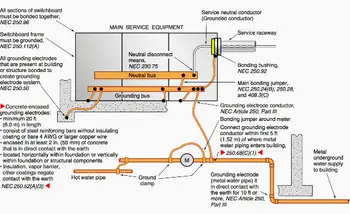Our Grounding and Bonding and the NEC Training 12-Hour Live Online Course Is Founded On Article 250 of The National Electrical Code.
This interactive 12-hour live online instructor-led Grounding and Bonding and the NEC Training course takes an in-depth look at Article 250 of the National Electrical Code (NEC) and is designed to give students the correct information they need to design, install and maintain effective electrical grounding and bonding systems in industrial, commercial and institutional power systems.
One of the most important AND least understood sections of the NEC is the section on Electrical Grounding.
No other section of the National Electrical Code can match Article 250 (Grounding and Bonding) for confusion that leads to misapplication, violation, and misinterpretation. It's generally agreed that the terminology used in Section 250 has been a source for much confusion for industrial, commercial and institutional electricians. Thankfully, this has improved during the last few revisions to Article 250.
Article 250 covers the grounding requirements for providing a path to the earth to reduce overvoltage from lightning, and the bonding requirements for a low-impedance fault current path back to the source of the electrical supply to facilitate the operation of overcurrent devices in the event of a ground fault.
Our Electrical Grounding Training course will address all the latest changes to the Electrical Grounding rules included in the NEC.
Our course will cover grounding fundamentals, identify which grounding system tests can prevent safety and operational issues at your facilities and details regarding which tests can be conducted while the plant is in operation versus which tests require a shutdown will be discussed.
Proper electrical grounding and bonding of equipment helps ensure that the electrical equipment and systems safely remove the possibility of electric shock, by limiting the voltage imposed on electrical equipment and systems from lightning, line surges, unintentional contact with higher-voltage lines, or ground-fault conditions. Proper grounding and bonding is important for personnel protection, as well as for compliance with OSHA 29 CFR 1910.304(g) Grounding.
It has been determined that more than 70 per cent of all electrical problems in industrial, commercial and institutional power systems are due to poor grounding, and bonding errors. Without proper electrical grounding and bonding, sensitive electronic equipment is subjected to destruction of data, erratic equipment operation, and catastrophic damage. This electrical grounding and bonding training course will give participants a comprehensive understanding of practical applications of proper grounding and bonding practices that will comply with the National Electrical Code.
Increase Your Knowledge
- Focus On Specific Electrical Grounding And Bonding Problems And Consequences Relating To Fires, Safety Of Personnel, And Damage To Equipment
- Participate In A Discussion Of Electrical Grounding And Bonding Problems And How To Overcome Or Avoid Them
- Gain A Firm Foundation Of Knowledge For Your Next Project Involving Electrical Grounding And Bonding
- Develop Your Knowledge Of Theory And Practice
Learn About
- The Grounding and Bonding and the NEC Section 250
- Specific Grounding Problems, Installations And the National Electrical Code Requirements
- Testing Procedures For Industrial, Commercial And Institutional Electric Power Grounding Systems
- Practical Solutions To Grounding Problems
After Attending, You Will
- Work More Safely And Efficiently
- Have A Better Understanding Of The NEC
- Make Fewer Installation Mistakes And Pass Inspections More Easily
- Be More Aware Of The Benefits Of Good Grounding And Bonding Systems
- Be Better Prepared To Design Your Next Grounding And Bonding System
Without good grounding and bonding, sensitive electronic equipment is subjected to destruction of data, erratic equipment operation, and catastrophic damage. Allen G.W. Segall (IBM Study) determined that 88.5% of all disturbances are caused by transient overvoltage and, therefore, it is of critical importance to know the "state-of-the-art" protection technologies.
Inductive effects of lighting including transients, wiring errors, and code violations cause damages estimated at about $20 billion dollars in the US each year, based on the following considerations: risk to personnel, equipment replacement cost, repairs cost, and destroyed data. The economics: Loss of sales, Loss of production, Loss of work in progress. The knowledge acquired in this course will enable the participant to apply correct electrical installation procedures according to the NEC, effective cabling and state-of-the-art technologies available for the protection of equipment and circuits. A code violation poses hazards to human life and equipment.



